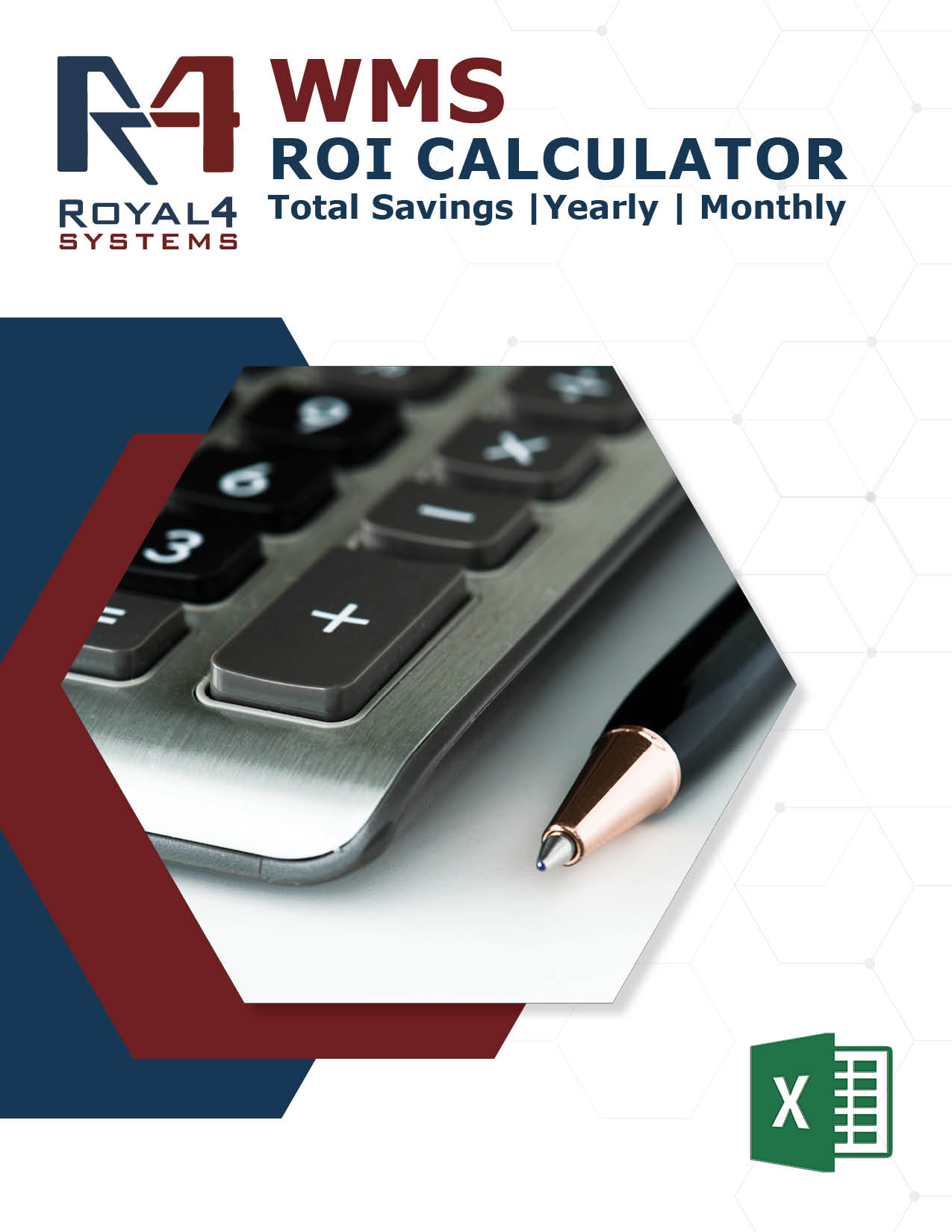Cloud WMS – WISE, SAAS
Explore how Royal 4 Systems’ Cloud WMS can enhance your business processes with our proven solution, resulting from four decades of WMS developments.
Complete Cloud WMS Solution
Built from the Ground Up for the Cloud
- Cloud Hosted Server & On-Premise Data Center options can handle the most complex setups, configurations, and integrations we offer.
- For your business, government agencies, manufacturers & distributors alike. The warehouse is the critical hub of the business. The central depot through which everything must pass – from raw materials waiting to be manufactured into finished goods. To product waiting for shipment downstream to a distribution center, retailer, or end-customer.
- WISE – Cloud WMS can be applied throughout all core warehouse processes, transforming the warehouse into a competitive advantage.
ROYAL 4 SYSTEMS | WISE | CLOUD WMS
Take Logistics Automation into the cloud. Our warehouse management application suite (WISE) is the core of our Supply Chain Solution.
WISE Cloud WMS Covers all other significant details regarding your operations.
User-Defined Location Rules Such As:
- Package Types
- Picking Rules
- Shipment Procedures
- Packaging Techniques
The WISE Warehouse Management System Cloud then optimizes these tasks for you based on detailed algorithmic rule engines. Moreover, extensive WISE Functions are available to improve the distribution center’s operations such as minimizing costs and increasing productivity.
“In the 12 years that WISE has been supporting the logistics operations at Poiesz, WISE has proven itself as a stable Warehouse Management System for our supermarket distribution centers. A WMS in which you can quickly configure thanks to the flexibility of the application.”

“There are two things I look at when reviewing software systems – functionality and after-the-sale support. The WISE warehouse management system has provided superior functionality to our Distribution group since 2002. Royal 4 is the “gold standard” I use for evaluating vendor support.”

Reliability
Our Cloud Data Center has been built with full redundancy capabilities. Therefore, it is less likely to go down than an individual or legacy customer system. Battery-powered backups and generators support cloud data centers. Also, they usually have co-location sites where the systems run if all of these back-ups fail. Thus with Royal 4 Cloud WMS, you will not lose the information stored even if your Internet connection drops. Overall, if the data center goes down for a brief or extended period: Users are typically able to continue work uninterrupted.
Security
Clearly, an ASP’s core business is to offer their customers applications over the Internet in a private, secure environment. Hence ASP solutions utilize the latest security technology, including firewalls and encryption. Our Cloud WMS Security is designed to protect privacy by preventing initial entry into an individual customer’s database. Secondly, there is continual monitoring as well. Also, ASPs tend to be early adopters of the latest advances in security technology. In contrast, many “legacy” and “homegrown” systems cannot maintain this same security level. For these reasons, Royal 4 System Cloud WMS is the best solution for a secure environment.
Upgrades / Backups
Complex software upgrades are a thing of the past if you choose an ASP-based offering. For instance, all software upgrades are performed seamlessly by the ASP (application service provider) as part of the subscription fee. Also, ASP’s perform automatic backups centrally in a sophisticated data center. Therefore, there is no need for any file backups to be done locally. Moreover, the Cloud WMS database automatically backs up at predetermined times to secure access to the most up-to-date information. Undoubtedly, the Royal 4 Systems Cloud Warehouse Management System provides the latest enhancements to keep your systems running smoothly.
ROYAL 4 CLOUD WMS INBOUND FUNCTIONALITY

RADIO FREQUENCY
Without a doubt, radio frequency scanners, RFIDs, and Barcodes are the backbone of most warehouse transactions. Above all, WISE users utilize the WMS’s intelligence at incredible speeds and accuracy with:
- Automatic Data Collection
- Real-Time Transaction Captures
- Flexible, Dynamic Menus
Furthermore, all warehouse functions are performed and updated in real-time. So the moment a task is complete, the next task in the sequence is triggered. Suppose a rush order is sent to the warehouse floor that needs quick processing. WISE can adjust the open tasks, immediately giving that order priority over the existing open pick tasks.
- Importantly, WISE is one of the only Cloud Warehouse Management Systems (WMS) available today that: Runs the same language on the databases, clients, and RF devices.
To accomplish this task, WISE seamlessly runs its own programs on the RF devices via terminal emulation. Not only that, it can support any brand of RF devices commercially available today: Zebra (Symbol / Telxon), Intermec, Honeywell LXE, Psion Teklogix, or Janam. Currently, WISE supports over 32 standard warehouse RF functions.

BARCODING
Standardized label formats used by trading partners contain detailed unique bar codes. Accordingly, barcode compliance labels are often used for shipping, containers, pallets, cartons, or individual pieces. Notably, WISE Cloud WMS can interface with numerous bar-code labeling software products. Also, the labels conveniently have common compliance standards set up as templates. When it comes to barcoding, Royal 4 Systems has you and your packages covered.

RETURNS
When items or shipments are returned to the warehouse, WISE Cloud WMS recognizes and captures the shipment’s unique data. Next, RF’s direct the receiver to input the items’ current condition, the reason for the return, and the return’s fault. Based on the values inputted for these three variables, Lastly, WISE will direct the warehouse personnel to take a specific user-defined action. i.e., Put items back in general stock. Put items in staging for future delivery. Take to re-work or repair. Send back to the manufacturer or to scrap.

ASSEMBLY / KITTING
Assembly/kitting is the process of gathering parts and/or products to make finished goods made up of multiple components. For example, through a process called backflushing, the material is issued automatically when production is posted against an operation. Subsequently, the backflushing program will use the quantity completed to calculate through the bill of materials. This includes the quantities of the components used and the reduction of on-hand balances accordingly.

QUALITY ASSURANCE
At receipt, WISE Cloud WMS can determine the shipment parameters to sample for significant quality control enhancements. Namely, these parameters consist of percentages of items by product ID, group code, vendor, and/or any combination. Next, the system will then generate the tasks to move those materials that require quality assurance procedures. Any rejected lots will be flagged in the system to avoid carrying out putaway and allocation tasks. WISE’s extensive Quarantine Functionality: Enables the managers to put an item, group, location, or even zone into Quarantine until proper procedures are followed.

RECEIVING
The WISE inbound module consists of a detailed set-up for all inventory types that could be received into a warehouse. Including purchase orders, warehouse transfers, work orders, advanced shipment notices (ASN’s), returned materials, and unexpected receipts. Based on the type of product coming into the receiving door: WISE Cloud WMS will direct the following steps after the point of receipt:
- Total visibility of all inbound orders.
- Complete support of ASN’s which can either be sent directly to WISE or via the host system.
- A simple single scan of a bar code, pallet ID, or pallet license plate.
- A single receiver can work on multiple incoming orders simultaneously.
- Multiple receiving personnel can work on a single order.
- Personnel can receive unexpected shipments.
- When the warehouse receives the goods: WISE captures all information possible, including: All Lot Numbers, Serial Numbers, and All Dates (Create, Manufacture, Expiration, etc.).

CROSSDOCKING
Cross-docking is a valuable tool in our Cloud WMS to increase warehouse efficiencies and speed order processing. For instance: An item is received into available inventory while the same item is required for an outbound order waiting for processing: WISE triggers the immediate tasks necessary to take the goods from the receiving dock to the packing station or shipping door to complete the shipment. Thus eliminating all putaway and picking tasks that would have been necessary to store the item and then pull again.

RFID - (UPC TO EPC)
Radio Frequency Identification (RFID) represents the next technology for retailing and distribution and is frequently used with our Cloud WMS. Specifically, these tags convey encrypted information that uniquely identifies items at the case, pallet, or container level. Often called “Smart Tags,”: RFIDs are essentially chips with antennas that transmit Electronic Product Codes (EPC’s) instead of the standard printed UPCs. Also, RFID tags can potentially be embedded into the product itself, becoming an indistinguishable part of product labeling or structure. Importantly, the tag’s information is transmitted automatically, so there is no need to unpack or scan individual bar code labels. Hence users experience improved inventory accuracy, reduced labor costs, and significant operational gains, translating into increased savings and higher value.

PUTAWAY
Extensive putaway functionality enables the warehouse to utilize many different styles and methods of putaway techniques. Using RF’s, WISE directs the users to the proper location and correct equipment with the most efficient route and manner. Next, RF putaway transactions are confirmed with a location bar-code scan to ensure real-time inventory accuracy. Based on a user-defined configuration, WISE will generate the putaway tasks to most efficiently direct warehouse personnel. For example, put away by the item itself, the product group, the locations, and/or any combination of the three.
Moreover, WISE incorporates consolidation rules with the product and location’s dimensions (also referred to as cubing). Further, the cubing functionality utilizes the product dimensions, weight, and cube information to accurately ensure each location’s viability for putaway. Moreover, this will prevent product damage by specifying item-specific or location-specific maximum load stacking parameters.
ROYAL 4 CLOUD WMS INTERNAL FUNCTIONALITY

INVENTORY CONTROL

REPLENISHMENT / FORWARD PICK
If you have Pick and pack operations that require replenishment activities, WISE supports this. Furthermore, it maintains inventory levels in forward pick locations and controls the movement of items. Particularly from the reserve or bulk storage locations to the higher volume forward pick locations. Importantly, warehouse employees are directed to complete replenishments based on location or item minimums and maximums. Further, warehouse managers can perform a “mock” allocation of the day’s orders. As a result, verifying available stock in the forward pick locations. Consequently, if there is not enough inventory available to fulfill the day’s orders. Importantly, WISE will automatically generate the pick tasks from the bulk locations to adequately supply the forward pick locations.

PRODUCT LOCATION
Dynamic space management is another key feature of WISE. First, the distribution center’s layout is set up, and the attributes of products and locations are defined. Next, the system will manage the space according to the availability, volume, weight, and attributes required for the product. As a result, the system can report the location or locations of a particular product. Further, reporting its current status, whether on-hand, allocated, available, or potential. Importantly WISE utilizes the item’s and location’s “cubes,” to calculate the volume and denote the capacity of the item’s location.

MULTIPLE UNITS OF MEASURE
The unit of measure describes how the quantity of an item is tracked in the inventory system. Namely, “eaches” is the most common unit of measure. It means that each individual item is considered one unit. In contrast, an item that uses “cases” as the unit of measure would be tracked by the number of cases. Other examples of units of measure include: Pallets, Pounds, Ounces, Linear Feet, Square Feet, Cubic Feet, Gallons, Thousands, Hundreds, Pairs, and Dozens… Importantly, WISE gives the user the ability to view all inventory instances in their multiple units of measure simultaneously.

PHYSICAL / CYCLE COUNT
Upon implementation and before commissioning of the system, a few steps must be taken. First, a warehouse-wide physical inventory is taken to enter every item of the system per its precise location. Further, a scan of the location, followed by scans of the items, ensures the item-location match. After implementation, WISE’s Dynamic Intelligent Cycle Counting Functionality will handle all future counts. Conveniently, the WISE cycle counts do not require an inventory freeze. Moreover, the counts are automatically triggered in the background per user-defined requirements. Further, cycle counts can be conducted per location, zone, product group, or item ID. A discrepancy cycle count is triggered whenever there is a putaway or pick task completed. Clearly, if there is a difference in the actual quantities and the expected quantities, there is an alert. Consequently, that location is then put on a temporary hold, and a count is triggered.
ROYAL 4 CLOUD WMS OUTBOUND FUNCTIONALITY

ORDER PROCESSING
WISE’s Order Management functionality is a flexible tool used to group and release orders for shipment. This easy-to-use functionality gives the manager the capabilities of releasing single orders or groups of orders based on: The order number, customer ID, destination, dates, FIFO/LIFO carriers, priorities, and any combination thereof. Conveniently, managers can cancel orders immediately at any point in the warehouse order process. Then, WISE will generate all the necessary tasks to re-stock the items already in the picking or shipping process. Specific Order Prioritization pushes orders that require special handling or expediting to automatically be assigned in the system. As a result, they receive priority within the task pool.

SHIPPING
After the items for an order have gone through all of the user-defined steps, including pick, pack, and palletize, they can then be shipped. Additionally, the orders can be consolidated into one shipment based on the order number, container, carrier, wave, zip code, or state. WISE’s detailed shipping logic allows for these variables and any combination thereof.

LOAD MANAGEMENT

PICKING
WISE gives the warehouse management the flexibility to release orders to the warehouse floor to be picked and processed. Clearly, a paperless warehouse is the goal of any WMS; but, if printed picklists are required, WISE can deliver a simple hybrid of the two. *If a paper-based system is required, please see the WISE-Paper section of the product information brochure.

WAVE PICKING
Using RF technology, a release of an order or group of orders is called a wave. WISE can pick by wave, order, priority demands, pallet, partial pallet, piece, zone, location, and customer. Furthermore, picks are assigned to individual employees based on user-defined priorities, product/order attributes, security clearance, and internal warehouse path sequences. Additionally, all details of the picking tasks are recorded in a detailed WISE transaction log. Thus reporting employee, unit-of-measure, destination, and transaction time stamps. Therefore, when it comes to wave picking, WISE Cloud WMS has you covered.

SHIPMENT / FREIGHT CONSOLIDATION
With WISE, you can consolidate orders being processed at different times for the same destination at the time of shipping. Therefore, reducing transportation charges, including UPS hundredweight, LTL carrier, or others. As a result, WISE Shipment and freight consolidations save customers money.

OUTBOUND DOCUMENTATION
At shipping, all of the necessary outbound documentation is produced, including but not limited to invoice, packing lists, shippers export doc/ AES transmission, shippers letter of instruction, NAFTA certificates, bank document, domestic bills of lading, dock receipt, hazardous goods documents, and domestic carrier labels.

PACKING
Many different packing methods are supported by WISE. The most common is to pick from general storage, then take the goods to the predetermined packing stations where the “packer” takes over the next step of the order’s process. If the user has defined that they are picking an individual order or orders, WISE can then pick from general storage locations and put the items directly into the packing container ready for shipment. This is also termed “palletization” if the packing container is a pallet and the entire pallet is used to ship. WISE’s cartonization functionality enables the warehouse manager to use the item’s cube information (based upon entered weight and dimensions of the merchandise) to be packed for put-away for the best location space utilization.

PARCEL CARRIERS
Integrate directly to each of the individual shipping manifest systems of the parcel carrier companies with WISE. Users can automatically send the shipping manifest to UPS, Federal Express, or others, ensuring accurate billing and shipment tracking. Subsequently, the tracking and freight information is then stored in WISE for reference and automatic email notifications.







